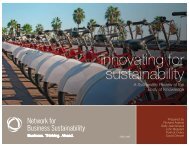embedding sustainability in organizational culture - Network for ...
embedding sustainability in organizational culture - Network for ...
embedding sustainability in organizational culture - Network for ...
You also want an ePaper? Increase the reach of your titles
YUMPU automatically turns print PDFs into web optimized ePapers that Google loves.
Chapter 1: 5: Introduction Build<strong>in</strong>g Momentum <strong>for</strong> Change<br />
46<br />
and discuss<strong>in</strong>g and debat<strong>in</strong>g ideas contributed to an <strong>in</strong>novation-supportive and<br />
<strong>in</strong>clusive <strong>culture</strong>.<br />
More research needs to be done to understand how <strong>in</strong>ternal knowledge-shar<strong>in</strong>g can<br />
be best facilitated to support <strong>susta<strong>in</strong>ability</strong> implementation.<br />
assessment: Weakly supported<br />
ShaRE knowlEdgE ExtERnally: Exchange <strong>in</strong><strong>for</strong>mation about ef<strong>for</strong>ts<br />
to embed <strong>susta<strong>in</strong>ability</strong> with other organizations to improve everyone’s<br />
<strong>susta<strong>in</strong>ability</strong> per<strong>for</strong>mance<br />
• Participate <strong>in</strong> knowledge shar<strong>in</strong>g opportunities <strong>in</strong>itiated by <strong>in</strong>dustry<br />
associations<br />
• Jo<strong>in</strong> organizations that br<strong>in</strong>g together other organizations that are<br />
grappl<strong>in</strong>g with <strong>susta<strong>in</strong>ability</strong><br />
Shar<strong>in</strong>g experiences with other organizations and groups to learn more about how<br />
they are work<strong>in</strong>g to solve <strong>susta<strong>in</strong>ability</strong> issues has mutually beneficial outcomes.<br />
Often other organizations are work<strong>in</strong>g on address<strong>in</strong>g similar <strong>susta<strong>in</strong>ability</strong><br />
issues and ask<strong>in</strong>g the same <strong>susta<strong>in</strong>ability</strong> questions. Acknowledg<strong>in</strong>g that shar<strong>in</strong>g<br />
<strong>in</strong><strong>for</strong>mation with competitors is not necessarily harmful is an important step.<br />
By shar<strong>in</strong>g best practices and key learn<strong>in</strong>gs, organizations can work together to<br />
generate <strong>susta<strong>in</strong>ability</strong> solutions (Ethical Corporation, 2009).<br />
Clarke and Roome (1999) propose that companies engage <strong>in</strong> knowledge shar<strong>in</strong>g<br />
<strong>in</strong> order to <strong>in</strong><strong>for</strong>m, confirm and validate their own <strong>in</strong>ternal approaches to<br />
<strong>susta<strong>in</strong>ability</strong>. Beyond this, we were unable to f<strong>in</strong>d work that looked back <strong>in</strong>to the<br />
organization to th<strong>in</strong>k about the impact of shar<strong>in</strong>g ideas with the outside world.<br />
assessment: Weakly supported<br />
collaBoRatE: work with other organizations to try to achieve shared<br />
<strong>susta<strong>in</strong>ability</strong> goals<br />
• Collaborate with other organizations<br />
• Create <strong>organizational</strong> partnerships<br />
• Cooperate with regulators, NGOs and external stakeholder groups<br />
Solv<strong>in</strong>g <strong>susta<strong>in</strong>ability</strong> is, <strong>in</strong> many ways, a shared responsibility and not a competitive<br />
race. The highly complex, multifaceted, and multi-stakeholder issues and challenges<br />
fac<strong>in</strong>g organizations will require collective attention and participation to be<br />
overcome. Mak<strong>in</strong>g headway on <strong>susta<strong>in</strong>ability</strong> issues sometimes requires more than<br />
share <strong>in</strong><strong>for</strong>mation shar<strong>in</strong>g. To achieve real progress on <strong>susta<strong>in</strong>ability</strong> issues, it may<br />
be necessary to work with some unlikely partners like competitors, governments or<br />
non-governmental organizations.<br />
Buysse and Verbeke (2003) describe how organizations with advanced <strong>susta<strong>in</strong>ability</strong><br />
agendas often work with external stakeholders such as regulators and environmental<br />
NGOs to develop environmental standards, or <strong>for</strong>m strategic alliances with<br />
environmental groups, or even competitors, to address complex environmental<br />
problems. Industries can band to together to develop best practices (Adriana, 2009)<br />
or to develop new processes (Halme, 1995). When an organization opts to take on<br />
larger <strong>susta<strong>in</strong>ability</strong> challenges by work<strong>in</strong>g with other organizations, it can send a<br />
signal to those on the <strong>in</strong>side that management is serious about <strong>susta<strong>in</strong>ability</strong>.<br />
In the <strong>in</strong>novation literature, Mitleton-Kelly (2006) notes that <strong>in</strong>teract<strong>in</strong>g with<br />
and listen<strong>in</strong>g to feedback from stakeholders enabled one organization to build the<br />
concerns of their communities <strong>in</strong>to its <strong>in</strong>novation processes.<br />
While many researchers have explored <strong>in</strong>ter<strong>organizational</strong> collaborations <strong>in</strong> the<br />
<strong>susta<strong>in</strong>ability</strong> arena, we were unable to identify any that looked at the impact of<br />
these collaborations on the <strong>culture</strong>s of the participat<strong>in</strong>g organizations.<br />
assessment: proposed but not tested
















